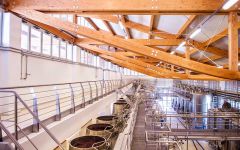Barone Ricasoli Albia Rose 2009


Product Details
Your Rating
Somm Note
Winemaker Notes
Delicious as an aperitif, serve with crudités and fresh cheeses, white meat and light cuisine.







The history of Italy cannot be told without including the prominent contributions of the Ricasoli family, who have produced wine since 1141. Ricasoli is documented as the oldest winery in Italy and the fourth oldest family business in the world. A beautiful illustration of the family tree in 1584 is one of the first images of the Chianti area and the family archives include export receipts dating back to the late 1600s. However, perhaps the most famous historical contribution came from Baron Bettino Ricasoli, who was not only twice the prime minister of Italy, but after 30 years of experimentation and documentation, developed the original formula for the Chianti wine that became the standard for the region.
The heart of the Ricasoli wine production comes from the Brolio castello, a magnificent castle located in the commune of Gaiole in Chianti, which was built as an outpost to defend Florence from the rival city of Siena. Within the estate, ancient cannonballs and even more recent WWII artillery shells have been found, evidence of the historical strategic importance of the castle with views of the entire Chianti Classico area. The 3,000 acre estate includes 580 acres of sustainably farmed vineyards, ranging in altitude from 800 to 1,500 feet. Each plot is harvested and fermented separately with meticulous dedication.
Baron Francesco Ricasoli has been at the helm of the winery since 1993 and with the deepest respect for his renowned ancestors, he has guided the estate in innovation and sustainable vineyard practices. The ongoing study of soil types and the clonal selection of the Brolio Sangiovese are among his greatest passions and he has been responsible for total renovation and re-mapping of the vineyards. Today, the wines are a reflection of the family’s nine hundred year dedication to quality winemaking and innovation at the Brolio estate.

Whether it’s playful and fun or savory and serious, most rosé today is not your grandmother’s White Zinfandel, though that category remains strong. Pink wine has recently become quite trendy, and this time around it’s commonly quite dry. Since the pigment in red wines comes from keeping fermenting juice in contact with the grape skins for an extended period, it follows that a pink wine can be made using just a brief period of skin contact—usually just a couple of days. The resulting color depends on grape variety and winemaking style, ranging from pale salmon to deep magenta.

One of the most iconic Italian regions for wine, scenery and history, Tuscany is the world’s most important outpost for the Sangiovese grape. Tuscan wine ranges in style from fruity and simple to complex and age-worthy, Sangiovese makes up a significant percentage of plantings here, with the white Trebbiano Toscano coming in second.
Within Tuscany, many esteemed wines have their own respective sub-zones, including Chianti, Brunello di Montalcino and Vino Nobile di Montepulciano. The climate is Mediterranean and the topography consists mostly of picturesque rolling hills, scattered with vineyards.
Sangiovese at its simplest produces straightforward pizza-friendly Tuscan wines with bright and juicy red fruit, but at its best it shows remarkable complexity and ageability. Top-quality Sangiovese-based wines can be expressive of a range of characteristics such as sour cherry, balsamic, dried herbs, leather, fresh earth, dried flowers, anise and tobacco. Brunello, an exceptionally bold Tuscan wine, expresses well the particularities of vintage variations and is thus popular among collectors. Chianti is associated with tangy and food-friendly dry wines at various price points. A more recent phenomenon as of the 1970s is the “Super Tuscan”—a red wine made from international grape varieties like Cabernet Sauvignon, Merlot, Cabernet Franc and Syrah, with or without Sangiovese. These are common in Tuscany’s coastal regions like Bolgheri, Val di Cornia, Carmignano and the island of Elba.
